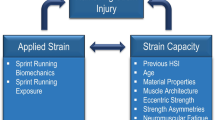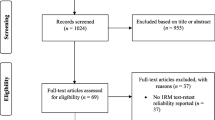Abstract
Purpose
The purpose of this systematic review was to assess whether LBP patients demonstrate signs of splinting by evaluating the reactions to unexpected mechanical perturbations in terms of (1) trunk muscle activity, (2) kinetic and (3) kinematic trunk responses and (4) estimated mechanical properties of the trunk.
Methods
The literature was systematically reviewed to identify studies that compared responses to mechanical trunk perturbations between LBP patients and healthy controls in terms of muscle activation, kinematics, kinetics, and/or mechanical properties. If more than four studies reported an outcome, the results of these studies were pooled.
Results
Nineteen studies were included, of which sixteen reported muscle activation, five kinematic responses, two kinetic responses, and two estimated mechanical trunk properties. We found evidence of a longer response time of muscle activation, which would be in line with splinting behaviour in LBP. No signs of splinting behaviour were found in any of the other outcome measures.
Conclusions
We conclude that there is currently no convincing evidence for the presence of splinting behaviour in LBP patients, because we found no indications for splinting in terms of kinetic and kinematic responses to perturbation and derived mechanical properties of the trunk. Consistent evidence on delayed onsets of muscle activation in response to perturbations was found, but this may have other causes than splinting behaviour.



Similar content being viewed by others
References
Wolf SL, Nacht M, Kelly JL (1982) EMG feedback training during dynamic movement for low back pain patients. Behav Ther 13:395–406
Keefe FJ, Hill RW (1985) An objective approach to quantifying pain behavior and gait patterns in low back pain patients. Pain 21:153–161
Marras WS, Wongsam PE (1986) Flexibility and velocity of the normal and impaired lumbar spine. Arch Phys Med Rehabil 67:213–217
Ahern DK, Follick MJ, Council JR, Laser-Wolston N, Litchman H (1988) Comparison of lumbar paravertebral EMG patterns in chronic low back pain patients and non-patient controls. Pain 34:153–160. doi:10.1016/0304-3959(88)90160-1
Lamoth CJC, Meijer OG, Wuisman PIJM, van Dieën JH, Levin MF, Beek PJ (2002) Pelvis-thorax coordination in the transverse plane during walking in persons with nonspecific low back pain. Spine (Phila Pa 1976) 27:E92–E99. doi:10.1097/00007632-200202150-00016
van den Hoorn W, Bruijn SM, Meijer OG, Hodges PW, van Dieën JH (2012) Mechanical coupling between transverse plane pelvis and thorax rotations during gait is higher in people with low back pain. J Biomech 45:342–347. doi:10.1016/j.jbiomech.2011.10.024
Hodges PW, Tucker K (2011) Moving differently in pain: a new theory to explain the adaptation to pain. Pain 152:S90–S98. doi:10.1016/j.pain.2010.10.020
Moorhouse KM, Granata KP (2007) Role of reflex dynamics in spinal stability: intrinsic muscle stiffness alone is insufficient for stability. J Biomech 40:1058–1065. doi:10.1016/j.jbiomech.2006.04.018
Dideriksen JL, Negro F, Farina D (2015) The optimal neural strategy for a stable motor task requires a compromise between level of muscle cocontraction and synaptic gain of afferent feedback. J Neurophysiol 114:1895–1911. doi:10.1152/jn.00247.2015
Hodges PW, Coppieters MW, Macdonald D, Cholewicki J (2013) New insight into motor adaptation to pain revealed by a combination of modelling and empirical approaches. Eur J Pain 17:1138–1146. doi:10.1002/j.1532-2149.2013.00286.x
van Dieën JH, Cholewicki J, Radebold A (2003) Trunk muscle recruitment patterns in patients with low back pain enhance the stability of the Lumbar Spine. Spine (Phila Pa 1976) 28:834–841
Freddolini M, Strike S, Lee RYW (2014) The role of trunk muscles in sitting balance control in people with low back pain. J Electromyogr Kinesiol 24:947–953. doi:10.1016/j.jelekin.2014.09.009
Radebold A, Cholewicki J, Polzhofer GK, Greene HS (2001) Impaired postural control of the lumbar spine is associated with delayed muscle response times in patients with chronic idiopathic low back pain. Spine (Phila Pa 1976) 26:724–730
Shenoy S, Balachander H, Sandhu JS (2013) Long latency reflex response of superficial trunk musculature in athletes with chronic low back pain. J Back Musculoskelet Rehabil 26:445–450. doi:10.3233/BMR-130404
Leinonen V, Kankaanpaa M, Luukkonen M, Hanninen O, Airaksinen O, Taimela S (2001) Disc herniation-related back pain impairs feed-forward control of paraspinal muscles. Spine (Phila Pa 1976) 26:E367–E372
Liebetrau A, Puta C, Anders C, de Lussanet MHE, Wagner H (2013) Influence of delayed muscle reflexes on spinal stability: model-based predictions allow alternative interpretations of experimental data. Hum Mov Sci 32:954–970. doi:10.1016/j.humov.2013.03.006
Newcomer KL, Jacobson TD, Gabriel DA, Larson DR, Brey RH, An K (2002) Muscle activation patterns in subjects with and without low back pain. Arch Phys Med Rehabil 83:816–821
Radebold A, Cholewicki J, Panjabi MM, Patel TC (2000) Muscle response pattern to sudden trunk loading in healthy individuals and in patients with chronic low back pain. Spine (Phila Pa 1976) 25:947–954
Reeves NP, Cholewicki J, Milner TE (2005) Muscle reflex classification of low-back pain. J Electromyogr Kinesiol 15:53–60. doi:10.1016/j.jelekin.2004.07.001
Stokes IAF, Fox JR, Henry SM (2006) Trunk muscular activation patterns and responses to transient force perturbation in persons with self-reported low back pain. Eur Spine J 15:658–667. doi:10.1007/s00586-005-0893-7
Miller EM, Bazrgari B, Nussbaum MA, Madigan ML (2013) Effects of exercise-induced low back pain on intrinsic trunk stiffness and paraspinal muscle reflexes. J Biomech 46:801–805. doi:10.1016/j.jbiomech.2012.11.023
Ramprasad M, Shenoy DS, Singh SJ, Sankara N, Joseley SRP (2010) The magnitude of pre-programmed reaction dysfunction in back pain patients: experimental pilot electromyography study. J Back Musculoskelet Rehabil 23:77–86
Lariviere C, Forget R, Vadeboncoeur R, Bilodeau M, Mecheri H (2010) The effect of sex and chronic low back pain on back muscle reflex responses. Eur J Appl Physiol 109:577–590
Leinonen V, Kankaanpää M, Luukkonen M, Kansanen M, Hänninen O, Airaksinen O et al (2003) Lumbar paraspinal muscle function, perception of lumbar position, and postural control in disc herniation-related back pain. Spine (Phila Pa 1976) 28:842–848
Freddolini M, Strike S, Lee R (2014) Dynamic stability of the trunk during unstable sitting in people with low back pain. Spine (Phila Pa 1976) 39:785–790
Gotze M, Ernst M, Koch M, Blickhan R (2015) Influence of chronic back pain on kinematic reactions to unpredictable arm pulls. Clin Biomech 30:290–295
Notzel D, Puta C, Wagner H, Anders C, Petrovich A, Gabriel HHW (2011) Altered hip muscle activation in patients with chronic non-specific low back pain. Schmerz 25:199–206
Mok NW, Brauer SG, Hodges PW (2011) Changes in lumbar movement in people with low back pain are related to compromised balance. Spine (Phila Pa 1976) 36:E45–E52. doi:10.1097/BRS.0b013e3181dfce83
Navalgund A, Buford JA, Briggs MS, Givens DL (2013) Trunk muscle reflex amplitudes increased in patients with subacute, recurrent LBP treated with a 10-week stabilization exercise program. Mot Control 17:1–17
Jones SL, Hitt JR, DeSarno MJ, Henry SM (2012) Individuals with non-specific low back pain in an active episode demonstrate temporally altered torque responses and direction-specific enhanced muscle activity following unexpected balance perturbations. Exp Brain Res 221:413–426
Cholewicki J, Silfies SP, Shah RA, Greene HS, Reeves NP, Alvi K et al (2005) Delayed trunk muscle reflex responses increase the risk of low back injuries. Spine (Phila Pa 1976) 30:2614–2620. doi:10.1097/01.brs.0000188273.27463.bc
Reeves NP, Cholewicki J, Narendra KS (2009) Effects of reflex delays on postural control during unstable seated balance. J Biomech 42:164–170. doi:10.1016/j.jbiomech.2008.10.016
Lamoth CJ, Meijer OG, Daffertshofer A, Wuisman PI, Beek PJ (2006) Effects of chronic low back pain on trunk coordination and back muscle activity during walking: changes in motor control. Eur Spine J 15:23–40. doi:10.1007/s00586-004-0825-y
Pataky TC, Vanrenterghem J, Robinson MA (2016) The probability of false positives in zero-dimensional analyses of one-dimensional kinematic, force and EMG trajectories. J Biomech 49:1468–1476. doi:10.1016/j.jbiomech.2016.03.032
Hodges P, van den Hoorn W, Dawson A, Cholewicki J (2009) Changes in the mechanical properties of the trunk in low back pain may be associated with recurrence. J Biomech 42:61–66. doi:10.1016/j.jbiomech.2008.10.001
Karayannis NV, Smeets RJEM, van den Hoorn W, Hodges PW (2013) Fear of movement is related to trunk stiffness in low back pain. PLoS One. doi:10.1371/journal.pone.0067779
Maaswinkel E, Griffioen M, Perez RSGM, van Dieën JH (2016) Methods for assessment of trunk stabilization, a systematic review. J Electromyogr Kinesiol 26:18–35. doi:10.1016/j.jelekin.2015.12.010
Granata KP, Rogers E, Moorhouse K (2005) Effects of static flexion-relaxation on paraspinal reflex behavior. Clin Biomech (Bristol, Avon) 20:16–24. doi:10.1016/j.clinbiomech.2004.09.001
McKay JL, Welch TD, Vidakovic B, Ting LH (2013) Statistically significant contrasts between EMG waveforms revealed using wavelet-based functional ANOVA. J Neurophysiol 109:591–602. doi:10.1152/jn.00447.2012
Pataky TC, Robinson MA, Vanrenterghem J (2013) Vector field statistical analysis of kinematic and force trajectories. J Biomech 46:2394–2401. doi:10.1016/j.jbiomech.2013.07.031
Hodges PW, Bui BH (1996) A comparis on of computer-based methods for the determination of onset of muscle contraction using electromyography. Electroencephalogr Clin Neurophysiol 101:511–519
Staude GH (2001) Precise onset detecti on of human motor responses using a whitening filter and the log-likelihood-ratio test. IEEE Trans Biomed Eng 48:1292–1305. doi:10.1109/10.959325
Author information
Authors and Affiliations
Corresponding author
Ethics declarations
Conflict of interest
None of the authors has any potential conflict of interest.
Electronic supplementary material
Below is the link to the electronic supplementary material.
Rights and permissions
About this article
Cite this article
Prins, M.R., Griffioen, M., Veeger, T.T.J. et al. Evidence of splinting in low back pain? A systematic review of perturbation studies. Eur Spine J 27, 40–59 (2018). https://doi.org/10.1007/s00586-017-5287-0
Received:
Revised:
Accepted:
Published:
Issue Date:
DOI: https://doi.org/10.1007/s00586-017-5287-0




